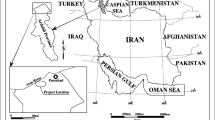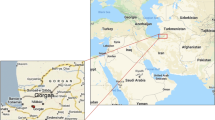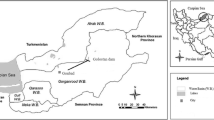Abstract
Growing water demands as well as inconsistency between water demand and water supply pose new challenges for water resources managers in arid regions. This study examines the strategies to tackle water shortage for a sustainable development in Shahrood, Iran. A contentious plan has been proposed to transfer water from the Caspian Sea in north of Iran to this region. Ensuring sustainable development, however, necessitates a strategic planning for water resources. The study develops all viable strategies for the region using Strengths, Weaknesses, Opportunities, and Threats (SWOT) analysis. Due to inability of the SWOT model to rank the alternatives, the developed strategies are ranked using Multi Criteria Decision Making (MCDM) models based on specified sustainable development criteria. The ranking is implemented using the compensatory models of Simple Additive Weighting (SAW) and Analytical Hierarchy Process (AHP), and the non-compensatory model of ELimination and Choice Translating REality (ELECTRE III). The results of all MCDM models introduce water transfer as the worst strategy for the region. Because of the uncertainty in the relative importance of specified criteria, sensitivity analysis is done for MCDM models by altering the criteria weights. The results show that the ELECTRE III method has lower sensitivity than the SAW and AHP methods to changes in the weights. Also, the compensatory methods exhibits a high dependency to the weights of some dominant criteria. Therefore, this research reveals that the rankings obtained from the ELECTRE III method are more reliable for decision makers to ensure a sustainable development in the region.




Similar content being viewed by others

References
Abrishamchi A, Ebrahimian A, Tajrishi M, Mariño MA (2005) Case study: application of multicriteria decision making to urban water supply. J Water Resour Plan Manag 131:326–335
Banihabib ME (2009) Water supply studies report for Shahrood city vol vol 11. Gamasiab consulting company
Banihabib ME, Azarnivand A, Peralta RC (2015) A new framework for strategic planning to stabilize a shrinking lake. Lake and Reservoir Management 31:31–43
Banihabib ME, Shabestari MH (2016) Fuzzy hybrid MCDM model for ranking the agricultural water demand management strategies in arid areas. Water Resour Manag 1:19. doi:10.1007/s11269-016-1544-y
Belton V, Stewart T (2002) Multiple criteria decision analysis: an integrated approach. Springer Science & Business Media
Chitsaz N, Banihabib ME (2015) Comparison of different multi criteria decision-making models in prioritizing flood management alternatives. Water Resour Manag 29:2503–2525
Gallego-Ayala J, Juízo D (2011) Strategic implementation of integrated water resources management in Mozambique: an A’WOT analysis. Phys Chem Earth, Parts A/B/C 36:1103–1111
Hazeltine B, Bull C (2003) Field guide to appropriate technology. Academic Press
Hill T, Westbrook R (1997) SWOT analysis: it's time for a product recall. Long Range Plan 30:46–52
Ho W (2008) Integrated analytic hierarchy process and its applications–a literature review. Eur J Oper Res 186:211–228
Hwang CL, Yoon K (1981) Multiple attribute decision making: method and applications, vol 186. Springer-Verlag, Berlin
Jeffreys I (2004) The use of compensatory and non-compensatory multi-criteria analysis for small-scale forestry. Small Scale For Econ Manag Policy 3:99–117
Kangas A, Kangas J, Pykäläinen J (2001) Outranking methods as tools in strategic natural resources planning. Silva Fennica 35:215–227
Kotter JP (2012) Leading change, with a new preface by the author. 1st edn. Harvard Business Review Press
Kurttila M, Pesonen M, Kangas J, Kajanus M (2000) Utilizing the analytic hierarchy process (AHP) in SWOT analysis—a hybrid method and its application to a forest-certification case. Forest Policy Econ 1:41–52
Mareschal B (1988) Weight stability intervals in multicriteria decision aid. Eur J Oper Res 33(1):54–64
Mikhailov L (2004) A fuzzy approach to deriving priorities from interval pairwise comparison judgements. Eur J Oper Res 159:687–704. doi:10.1016/S0377-2217(03)00432-6
Naseri Amin M (2011) Ranking of the important factors in locating dam site using multi criteria decision making (AHP, ELECTRE-III, TOPSIS); case study: Kamyaran and Mianrahan basin in kermanshah province. Tehran University, Iran
Roy B (1968) Classement et choix en présence de points de vue multiples Revue française d'automatique, d'informatique et de recherche opérationnelle. Recherche opérationnelle 2:57–75
Roy B (1991) The outranking approach and the foundations of ELECTRE methods. Theor Decis 31:49–73
Saaty TL (1980) The analytic hierarchy process: planning, priority setting, resources allocation. McGraw, New York
Srdjevic B, Medeiros YDP (2008) Fuzzy AHP assessment of water management plans. Water Resour Manag 22:877–894
Srdjevic B, Medeiros Y, Faria A (2004) An objective multi-criteria evaluation of water management scenarios. Water Resour Manag 18:35–54
Tsakiris G, Spiliotis M (2011) Planning against long term water scarcity: a fuzzy Multicriteria approach. Water Resour Manag 25:1103–1129. doi:10.1007/s11269-010-9692-y
United Nation (UN) (2000) United Nation Millennium Declaration. General Assembly Resolution (A/RES/55/2). UN Millennium Summit, New York, U.S.A
United Nation Development Program (UNDP) (2008) Human development indices: a statistical update New York, USA
Yang X-l, J-h D, Hou H (2013) Application of a triangular fuzzy AHP approach for flood risk evaluation and response measures analysis. Nat Hazards 68:657–674
Yüksel İ, Dagdeviren M (2007) Using the analytic network process (ANP) in a SWOT analysis–a case study for a textile firm. Inf Sci 177:3364–3382
Author information
Authors and Affiliations
Corresponding author
Rights and permissions
About this article
Cite this article
Banihabib, M.E., Hashemi-Madani, FS. & Forghani, A. Comparison of Compensatory and non-Compensatory Multi Criteria Decision Making Models in Water Resources Strategic Management. Water Resour Manage 31, 3745–3759 (2017). https://doi.org/10.1007/s11269-017-1702-x
Received:
Accepted:
Published:
Issue Date:
DOI: https://doi.org/10.1007/s11269-017-1702-x



